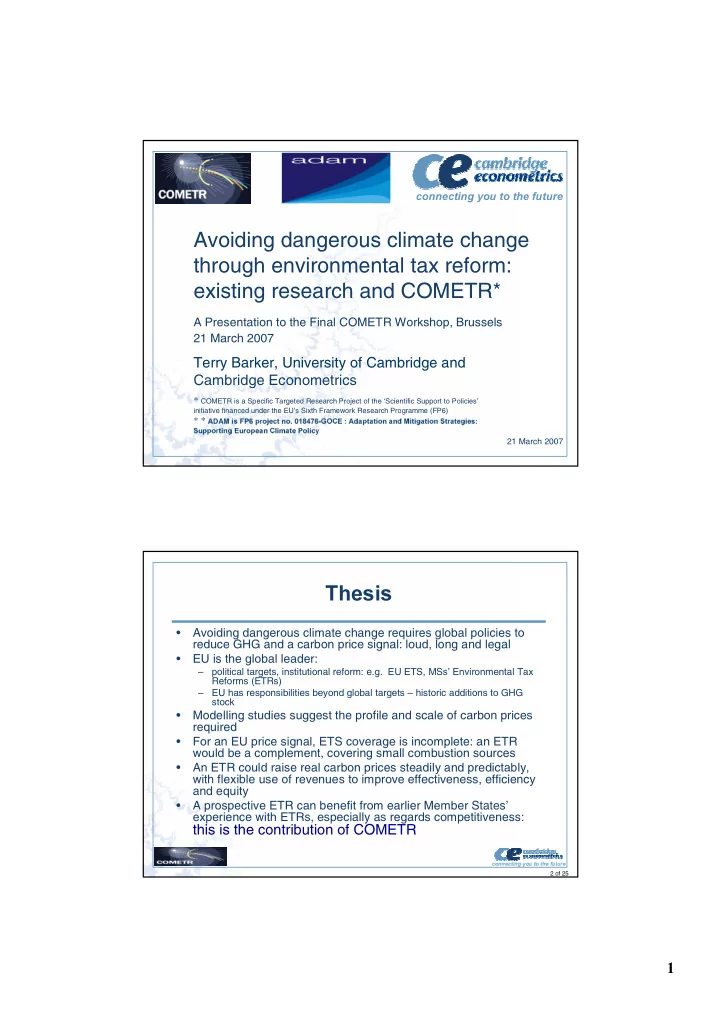

���������������������������� Avoiding dangerous climate change through environmental tax reform: existing research and COMETR* A Presentation to the Final COMETR Workshop, Brussels 21 March 2007 Terry Barker, University of Cambridge and Cambridge Econometrics * COMETR is a Specific Targeted Research Project of the ‘Scientific Support to Policies’ initiative financed under the EU’s Sixth Framework Research Programme (FP6) * * ����������������������������������� ���������������������������� ����������� !����������!��������"�#������"��$� 21 March 2007 ������ • Avoiding dangerous climate change requires global policies to reduce GHG and a carbon price signal: loud, long and legal • EU is the global leader: – political targets, institutional reform: e.g. EU ETS, MSs’ Environmental Tax Reforms (ETRs) – EU has responsibilities beyond global targets – historic additions to GHG stock • Modelling studies suggest the profile and scale of carbon prices required • For an EU price signal, ETS coverage is incomplete: an ETR would be a complement, covering small combustion sources • An ETR could raise real carbon prices steadily and predictably, with flexible use of revenues to improve effectiveness, efficiency and equity • A prospective ETR can benefit from earlier Member States’ experience with ETRs, especially as regards competitiveness: this is the contribution of COMETR ���������������������������� 2 of 25 �
������� 1. The costs of mitigating dangerous climate change 1. What is “dangerous”? 2. Implications for GHG abatement and CO2-eq. prices 2. Mitigation policies and Environmental Tax Reform (ETR) 1. Additional energy taxes, EU ETS, energy-efficiency regulation 2. The policy instrument and objective problem 3. Role of ETR 3. The problems of competitiveness and carbon leakage 1. Evidence from the literature (IPCC reports) 2. Importance of ex post evidence 4. The contribution of the COMETR project ���������������������������� 3 of 25 ���������������������������� �������� ������ • “dangerous” is an ethical and political issue • EU’s target of 2ºC above pre-industrial is very stringent and requires stabilisation below 450ppm CO 2- equivalent to have a 50% probability of being met • Stern, p. 284: “The current evidence suggests aiming for stabilisation somewhere within the range 450 - 550ppm CO 2 e. Anything higher would substantially increase risks of very harmful impacts..” • Most modelling scenarios have been for targets around 650ppm CO 2 eq (EMF19, EMF21) • Innovation Modelling Comparison Project (IMCP) – considered one scenario around 550 CO 2 eq (450 CO 2 only) – and focused on effects of Induced Technological Change (ITC) ���������������������������� 4 of 25 �
������������������ � ���������� ���������������� ����������������������������������������� �������������������������������� � Models - 450ppm ��������� � ���� CO2-only with �������� �� � � 20 E TC ����� ��������� 550ppm CO2- 0 �������� only without E TC � �������������� 2000 2025 2050 2075 2100 � -20 � � ��������� � � � 450ppm CO2- � ������ � -40 only without E TC � � � � ����������� � -60 � 550ppm CO2- � � ����������� only with ETC � -80 ����������� 450ppm CO2- -100 �������!�� only with ETC ����� Source: Barker, T., M. Qureshi, and J. Köhler, 2006: ���������������������������������������������������� ��������������������������������������������������������������������� Working Paper 89, Tyndall Centre for ���������������������������� Climate Change Research, Norwich, 63pp. 5 of 25 ����������������������������������������������������������������������� ������������������������������������������������������ ����� ��������������� ��������������� ����� ����� ��������������� ������������ ���������� �������������������������� � � ��� ������������������������ � � M odels - E M F21 450ppm v m odels: 300 300 GRAP E w ith E TC 4.5W/m 2 E P P A � 550ppm v � C O2-only � 250 250 � � � � w ithout E TC � � � � � � 200 200 � � E M F21 9- � � � 450ppm v � AIM 150 FUND m odel � � � � 150 w ithout E TC � average: � � 100 4.5W/m 2 100 550ppm v m ultigas 50 w ith E TC 50 E M F21 9- 0 m odel 0 450ppm v 2000 2025 2050 2075 2100 average: -50 w ith E TC 2000 2025 2050 2075 2100 4.5W/m 2 ����� � ���� C O2-only ����� ��������������� ������������ ������������� ����� ��������������� ��������������� ������� � � �� � � E M F21 M odels - m odels: 20 450ppm v 20 4.5W/m 2 w ith E TC � C O2-only � 0 � 0 550ppm v � � � 2000 2025 2050 2075 2100 2000 2025 2050 2075 2100 w ithout E TC � � � � E M F21 9- � � -20 � -20 � � m odel � � � � � � 450ppm v FU ND average: � -40 � � -40 � � w ithout E TC 4.5W/m 2 � � � � m ultigas � -60 � -60 � 550ppm v E M F21 9- E P P A � w ith E TC -80 m odel -80 average: -100 4.5W/m 2 450ppm v -100 C O2-only w ith E TC � ���� ����� ����� ��������������� ������������ ������������� �������������������� ��������������� �������� �� �� E M F21 m odels: M odels - 2.00 4.5W/m 2 450ppm v AM IGA 4 � � CO2-only w ith E TC � � 0.00 � � 2 � � 550ppm v � � 2000 2025 2050 2075 2100 w ithout E TC � -2.00 � 0 � E M F21 9- � � � � � m odel � 2000 2050 2100 � -2 � -4.00 � � 450ppm v � average: � � COM BAT � -4 w ithout E TC � 4.5W/m 2 -6.00 FU ND � � � � m ultigas � -6 -8.00 550ppm v AIM E M F21 9- -8 w ith E TC m odel -10.00 -10 E P P A average: 450ppm v ���������������������������� -12.00 4.5W/m 2 -12 w ith E TC GRAP E CO2-only � ���� ����� 6 of 25 �
Recommend
More recommend